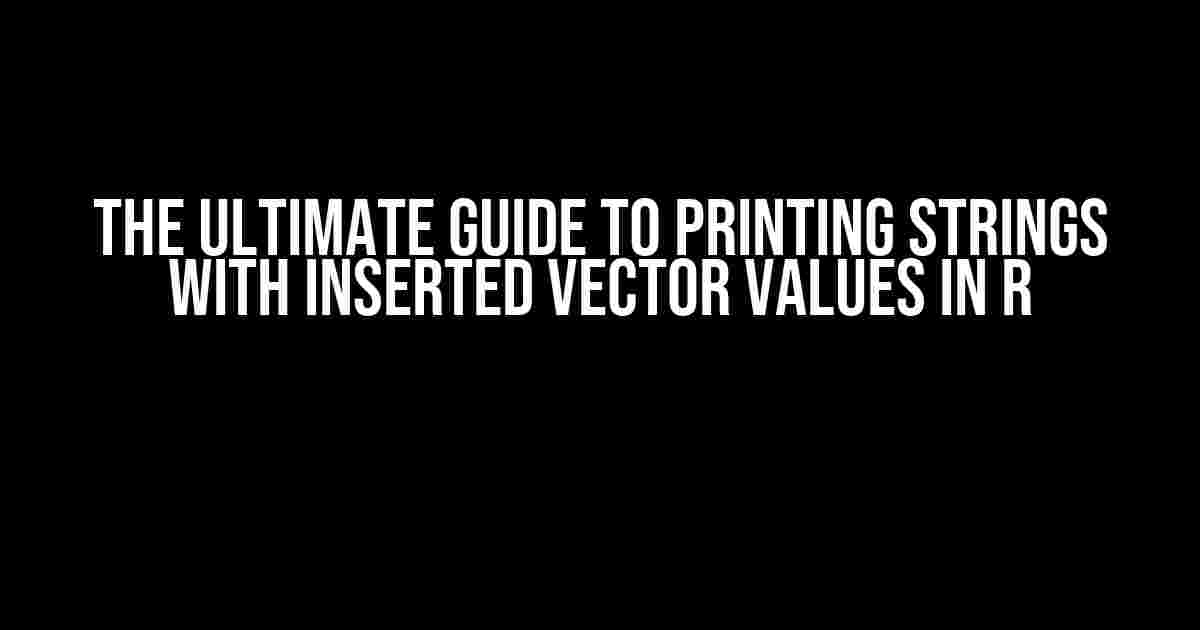Are you tired of struggling to print strings with inserted vector values in R? Do you find yourself stuck in a loop of frustration, trying to get your code to output the desired result? Fear not, dear R enthusiast, for this article is here to save the day! In this comprehensive guide, we’ll dive into the proper way to print strings with inserted vector values in R, covering the ins and outs of this essential skill.
The Problem with Printing Strings in R
Before we dive into the solution, let’s take a step back and understand the problem. In R, when you try to print a string with inserted vector values, you’ll often encounter issues with formatting, spacing, and interpolation. This can lead to output that’s less than ideal, making it difficult to present your data in a clear and concise manner.
> x <- c("a", "b", "c")
> print("The values are: ", x)
[1] "The values are: " "a" "b" "c"As you can see, the output is not exactly what we’re looking for. So, how do we fix this?
Introducing paste() and paste0()
The key to printing strings with inserted vector values in R is to use the paste() or paste0() functions. These functions allow you to concatenate strings and vectors, creating a clean and readable output.
The paste() Function
The paste() function is used to concatenate strings and vectors, using a space as the default separator. Here’s an example:
> x <- c("a", "b", "c")
> print(paste("The values are:", x))
[1] "The values are: a" "The values are: b" "The values are: c"As you can see, the output is much improved, but still not exactly what we’re looking for. This is where the paste0() function comes in.
The paste0() Function
The paste0() function is similar to paste(), but it doesn’t use a separator. This allows you to concatenate strings and vectors without any extra spaces or characters. Here’s an example:
> x <- c("a", "b", "c")
> print(paste0("The values are: ", x[1]))
[1] "The values are: a"Now we’re getting somewhere! But what if we want to print multiple vector values?
Printing Multiple Vector Values
To print multiple vector values, you can use the paste() or paste0() functions in conjunction with the collapse argument. Here’s an example:
> x <- c("a", "b", "c")
> print(paste(x, collapse = ", "))
[1] "a, b, c"By setting the collapse argument to a comma and a space (“, “), we can concatenate the vector values into a single string, separated by commas.
Using sprintf()
Another way to print strings with inserted vector values in R is to use the sprintf() function. This function allows you to create formatted strings using a specification string and a list of arguments.
> x <- c("a", "b", "c")
> print(sprintf("The values are: %s, %s, and %s", x[1], x[2], x[3]))
[1] "The values are: a, b, and c"In this example, we use the sprintf() function to create a formatted string, using the specification string “The values are: %s, %s, and %s”. The %s placeholders are replaced with the vector values, creating a clean and readable output.
Best Practices
When printing strings with inserted vector values in R, it’s essential to follow some best practices to ensure your code is readable, efficient, and effective.
- Use meaningful variable names**: Instead of using generic variable names like
x, use descriptive names that indicate what the variable represents. - Use consistent formatting**: Consistency is key when it comes to formatting your code. Choose a formatting style and stick to it.
- Test your code**: Before sharing your code with others, make sure it’s thoroughly tested and validated.
- Use comments and documentation**: Comments and documentation are essential for explaining your code to others (and yourself!). Use them liberally to clarify complex concepts and processes.
Common Mistakes to Avoid
When printing strings with inserted vector values in R, there are some common mistakes to avoid.
| Mistake | Description |
|---|---|
Not using paste() or paste0() |
Failing to use paste() or paste0() can result in incorrect output, with spaces and characters appearing unexpectedly. |
Not setting the collapse argument |
Failing to set the collapse argument can result in incorrect output, with vector values appearing on separate lines. |
Using sprintf() incorrectly |
Using sprintf() incorrectly can result in incorrect output, with formatting errors and unexpected characters. |
Conclusion
In conclusion, printing strings with inserted vector values in R is a crucial skill for any R enthusiast. By mastering the paste(), paste0(), and sprintf() functions, you’ll be able to create clean, readable, and intuitive output that effectively communicates your data.
Remember to follow best practices, avoid common mistakes, and test your code thoroughly to ensure your output is accurate and reliable.
With this comprehensive guide, you’ll be well on your way to becoming a master of printing strings with inserted vector values in R. Happy coding!
Last updated:
Frequently Asked Question
Get ready to unravel the mystery of printing strings with inserted vector values in R like a pro!
Q1: What is the most common mistake when printing strings with inserted vector values in R?
One of the most common mistakes is using the “+” operator to concatenate strings and vectors, which can lead to unwanted results. R doesn’t implicitly convert vectors to strings, so you need to use the paste() or paste0() function to combine them correctly!
Q2: What is the difference between paste() and paste0() functions in R?
The main difference is that paste() separates the strings with a space by default, while paste0() doesn’t add any separator. For example, paste(“Hello”, “World”) returns “Hello World”, whereas paste0(“Hello”, “World”) returns “HelloWorld”. Choose wisely, young padawan!
Q3: How do I print a string with inserted vector values using the paste() function?
Easy peasy! Use the following syntax: paste(“Your string”, vector_value, sep = “”). Replace “Your string” with your desired string, and vector_value with the vector you want to insert. The sep = “” argument ensures that there’s no separator between the string and the vector value.
Q4: Can I use the sprintf() function to print strings with inserted vector values in R?
Absolutely! The sprintf() function is a powerful tool for formatting strings. Use it like this: sprintf(“Your string %s”, vector_value). The %s is a placeholder for the vector value, and sprintf() will replace it with the actual value. Just make sure to match the number of placeholders with the number of vector values!
Q5: What if I want to print a string with multiple inserted vector values in R?
No problem! You can use the paste() or sprintf() function with multiple arguments. For example, paste(“Your string”, vector_value1, vector_value2, sep = “”) or sprintf(“Your string %s %s”, vector_value1, vector_value2). Just separate the arguments with commas, and R will take care of the rest!


